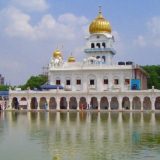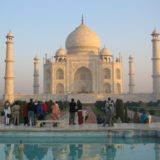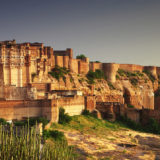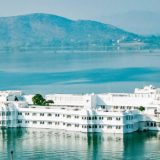After checking in at Auckland Airport early this afternoon we board our Singapore Airlines flight to Singapore.
We’ll arrive this evening and transfer to our hotel.
We have a morning at leisure in Singapore and early this afternoon we transfer to the airport for our flight to New Delhi.
On arrival at New Delhi airport we are met and transfer to our hotel.
After breakfast we start our day in Delhi with the following:
Visit the majestic Bangla Sahib Gurudwara, with its eye-catching golden dome glistening in the sun. A holy place for Sikhs across the world, the Gurudwara grounds include a community temple, a community kitchen, a school, a library and an art gallery.

Colonial Delhi
The Colonial Delhi trail will take us past the India Gate, a monument commemorating the deaths of over 70,000 Indian soldiers in the British Forces during World War I and older British buildings that house today’s Parliament and Secretariat.
Rickshaw Ride (Old Delhi)
The bazaars (shopping areas) in Old Delhi will amaze you – they are a kaleidoscope of colour, sound, and sensation which pulsate with heaving masses of people. We will be taking an exhilarating rickshaw ride through this labyrinth of shops and stalls – it’s a great way to experience a bazaar!
This evening we enjoy a welcome dinner at Spice Route Restaurant at The Imperial.
After breakfast, we will be transferred to Delhi airport to board our flight to Varanasi. On arrival at Varanasi airport we will be met and transfer to our hotel in a private vehicle.
This evening we witness the Aarti ceremony on the banks of the river Ganges.
Aarti Ceremony
No trip to Varanasi is complete without a visit to the banks of the river Ganges. Just before sunset, we will be guided to the steps that lead down into the river, to witness an Aarti Ceremony, an evening ritual of lighting lamps against the darkness and offering prayers to the river deity.
At the confluence of two tributaries of the Ganges River, Varanasi is a city of many names, bearing a history of over 3000 years, and had reached its zenith as a centre of religion and learning in the 7th century BC.
A city steeped in spiritual sanctity and knowledge, which three great world religions – Buddhism, Jainism and Hinduism and acknowledged as a place of homage. Later named Benaras, the city saw the establishment of the Benaras Hindu University, a pre-eminent centre of Sanskrit language, culture, philosophy and learning. As a thriving trade post for many centuries, Benaras was also an important centre of crafts and culture under the patronage of various rulers; and is world-renowned for its Benaras silk weaving motifs, metal and brass work, and for its wrestling tradition! Today, Varanasi’s riverbanks (known as ghats) with their temples, shrines and the sacred waters of the Ganges, draw millions of pilgrims seeking spiritual salvation.
Wake up early and drive to the riverside, where a boat will be waiting to take us on a cruise. As we head downriver, we will have a perfect vantage point to watch the many ghats (the steps that lead down to the river) come to life; with pilgrims in their bright orange robes, elderly women in colourful saris offering prayers as they pour water from little copper pots into the river, sadhus meditating or lighting lamps.
Our morning river experience will be accompanied by a live musician on board the boat.
We return to our hotel for breakfast and afterwards visit the Weavers Colony.
The source of the famous Benaras Silk and brocade, the weavers’ colony is a collection of Muslim families who have practiced the craft of weaving for decades. The fabric they spin is famous through the country for its compact weave and refined quality and is mostly used in making saris. Saris from Benaras are among the finest in India and are known for their gold and silver brocade or zari (embroidery with metallic threads), fine silk and opulent embroidery.
This afternoon we visit Sarnath.
Sarnath, a great centre of learning where the Buddha preached his first sermon on the Dharmachakra, his code of conduct. Today, a Bodhi tree commemorates Buddha’s initial moment of enlightenment during which he conceived the Eightfold Path to Nirvana.
After breakfast we drive to Varanasi airport to board our flight to Delhi.
On arrival at Delhi airport we are met and drive to Agra. A packed lunch will be provided at Delhi airport.
When we arrive in Agra we check in to our hotel.
The origins of the city of Agra can be traced back to the days of the Mahabharata, the epic poem of Great India when it was called Agrevana, meaning ‘the edge of the forest’. Agra served as capital for the Mughal Empire during the 16th and 17th centuries and flourished as a centre of art, drawing inspiration from Persian, Islamic, Turkish, Byzantine and Indian styles. It has been immortalized ever since by the Taj Mahal – a magnificent marble mausoleum that epitomises love; yet Agra has so many more monuments that tell a rich narrative of the tides and times of Man.
Wake up early and visit the magnificent Taj Mahal in the subtle morning light while it is still relatively uncrowded.
Taj Mahal
Agra has been immortalized by the magnificent mausoleum, which the emperor Shahjahan had built for his queen, Mumtaz; India’s own jewel in the list of 7 Wonders of the Modern World. Our storyteller guide will weave tales of Agra and the mausoleum, and the romance between Shahjahan and Mumtaz.

Later in the morning we enjoy an old city walk followed by a visit to Agra Fort, one of the most important and robustly built strongholds of the Mughals, embellished with several richly decorated buildings.
This afternoon we visit Itmad-Ud-Daulah.
Itmad-Ud-Daulah
Follow the road less travelled with Itmad-ud-Daulah, a marble tomb built for the grandfather of Mumtaz (the queen interred at the Taj Mahal) also known as Baby Taj; it is said to have inspired the Taj Mahal.
We meet inlay artisans and witness their craftsmanship of setting semi-precious stones into the marble floors to create floral motifs.
This evening we have dinner at our hotel.
This morning we start our drive to Jaipur. En-route we stop at the Abhaneri step wells.
Stepwells, unique to India, were used as reservoirs and provided respite from the summer heat. Sun shaded verandas, which you can enter, overlook what must be thousands of criss-crossing steep steps patterned like an upside down ‘V’ which descend deep into the abyss of the well.
The temple, adjacent to the step-well which was also used for ritual bathing before worshipping, is still active and devoted to the goddess Durga. Remains of intricate stone carvings of Hindu deities are found throughout the well area and as part of the temple structure.
Excavation of the site began in 1955 and the step-well and temple were open to the public in 1960 under the supervision of the Archaeological Survey of India. But Abhaneri is only just slowly finding its way onto traveller’s radar screens in recent years. It still offers the rare opportunity to sample a stunning architectural antiquity without the crowds.
We enjoy a picnic lunch in a beautiful spot overlooking the ravines, and then we continue our drive to Jaipur.
On arrival we check into our accommodation.
Erected during the 18th Century by the ruler of Amer as a ‘city of victory’, Jaipur was north India’s first planned city. Jaipur is often known as the ‘pink city’; some say because of the distinctive rosy sandstone used in its construction, others claim it was painted pink to welcome the Prince of Wales. Either way, the city is a beautiful symphony of the history with the present; well expressed in the planned, gridded network of streets juxtaposed with a bustling maze of by-lanes and bazaars; the traditional artisanal crafts offset against contemporary arts.
Today we start sightseeing in Jaipur with the following activities:
Hawa Mahal Observatory – Jaipur’s most ornate and most distinctive landmark is perfect for a photo stop. A visit to the Jantar Mantar Observatory, built in the early 1700s by Sawai Jai Singh II, Jaipur’s ruler and a keen astronomer will showcase Central Asia’s rich legacy of astronomy. Its sixteen massive instruments are works of art in themselves and some can forecast the weather even today!
City Palace
Visit the City Palace complex, the seat of the Maharajah of Jaipur, which consists of an impressive array of courtyards, gardens and buildings.
We enjoy lunch at Baradari restaurant at City Palace.

After lunch we visit Amer Fort and Anokhi Museum.
Amer Fort
The citadel of the Kachhawaha clan who later became the rulers of Jaipur. With its sprawling apartments, pleasure gardens, and temples, Amer is one of the most intricate and beautiful Rajput fortresses in all of India.
Anokhi Museum of Handprinting
Located in a magnificently restored haveli or mansion, the Anokhi Museum of Handprinting displays a selection of block printed textiles alongside images, tools and related objects, all chosen to provide an in-depth look into the complexity of this ancient tradition.
In the evening we drive to Dera Amer, spend time with elephants and have dinner.
Dera Amer – A Retreat for Elephants
Situated on the outskirts of Jaipur, this private retreat was once a scrubland, when the Singh family acquired an expanse of 180 acres. Dera Amer today is full of wilderness and natural beauty. Operating with an eco-sensitive mind set, with organic farming practices, implementation of solar paneled water pumps, drip irrigation, engaging and empowering the local communities, and adopting elephants and camels that were rescued from a life of hard labour. Meet the man who has been striving towards creating a positive effect on the environment and providing a natural habitat and a healing touch to the animals.
We enjoy a Rajasthani Folk Dance with a special organic farm fresh meal in the wilderness of Dera Amer.
After a leisurely breakfast we commence our drive to Jodhpur.
A packed lunch will be provided today.
On arrival we check into our accommodation.
Late afternoon we enjoy a guided walk in the bazaars of the old city where we can find everything from traditional handicrafts to copper pots and pans! Sardar Bazaar, as it is known, has several beautiful havelis primarily made of red sandstone. We follow this with a visit to the vegetable market – where the colours and varieties of local produce from gourds to beans, from leafy greens to tubers will showcase tropical produce at their best.
Epitomizing the romance and feudal splendour of Rajasthan with the majestic Mehrangarh Fort towering over it, the city of Jodhpur was once a flourishing trade centre for opium, silk and copper. Painted a brilliant shade of blue, Jodhpur has fort ramparts, colourful bazaars, and animated people with their storytelling traditions.
This morning we visit Mehrangarh Fort, one of the most majestic of Rajasthan’s forts; described by the author Rudyard Kipling as “the creation of angels, fairies and giants”. Its forbidding ramparts are in sharp contrast to the flamboyantly decorated palaces within. Founded in 1459, the sandstone fort was added to by later rulers between the 17th and 19th centuries. We explore the massive fort complex and the exquisite museum collection. From coronation thrones to pleasure palaces and sunken gardens, the Mehrangarh Fort houses a citadel of immense grandeur.

We then start our walking tour of the Blue City, the historic district that surrounds the foot of Mehrangarh Fort. The Blue City has a mysterious quality to its quiet lanes, exquisite havelis, and pale indigo walls. Many believe that the indigo was mixed in the lime to provide a cooling effect against the harshness of the desert sun. Our guide will take us through the by-lanes and we’ll learn more about the proud heritage of the inhabitants of the city.

Late afternoon we drive to Mharo Khet, a chemical-free farm on the outskirts of Jodhpur. The farm tour is entertaining and educational where we learn about the importance of sustainable farming, the benefits and challenges of chemical-less agricultural practices, and an opportunity to harvest some fruits/vegetables during the tour.
Enjoy an early dinner with a table-to-the-farm, pre-plated, plant-forward meal, which is an amalgam of art, freshness and flavour.
After breakfast we drive to Narlai.
On arrival we check into our accommodation.
Narlai is one of those places where the ways of life have been etched by the natural terrain that surrounds it. The rugged habitat in the Godwad countryside around Narlai also offers a safe haven to wildlife, including leopards. In this undulating landscape village folk share a deep connection with nature and a symbiotic relationship with the contours of the land, which have subtly influenced their beliefs and practices. Life in this 17th-century village has continued much as it was back in the day – peaceful and unhurried.
Later in the afternoon we take a guided walk around the village of Narlai for an authentic glimpse into rural living against the stunning backdrop of the Aravalli hills.
In the evening we enjoy a Step Well dinner and taste the flavour of true Rajasthani royal hospitality at the 16th-century Baoli (Stepwell) lit with hundreds of candles.
After breakfast we embark on a Leopard Safari around the region of Narlai looking for the elusive felines. The rugged Godwad countryside around Narlai suits the leopards and in recent times the number has increased.
Experience the thrill of a customized ride in our jeeps for a sighting of this beautiful and graceful cat. Not easy to spot as they blend very well into the background, these animals can sometimes be seen sunning themselves on the rocks or resting under the shade of a tree.
Later we commence our drive to Udaipur. En-route we stop at the Jain temples at Ranakpur.
Ranakpur Temples
Set in a secluded, wooded valley of the Aravalli Hills the 15th-century Ranakpur Temple’s grand scale, architectural complexity and sculptural ornamentation rank it among the finest examples of temple architecture. The main temple is dedicated to the founder of Jainism; Ranakpur is one among five holy places for Jain followers.
Today we have lunch at Mount Batten Lodge.
On arrival in Udaipur we check into our hotel.

Udaipur is an oasis nestled in the lap of the Aravalli Mountain range and it has a tranquil serenity that belies its tumultuous past. It was originally a thriving caravanserai and later became a capital of local, royal clans. Udaipur’s serene lakes, beautiful gardens and magnificent palaces lend it a nostalgia that has often earned it the acclaim of being one of the most romantic places in the world. Apart from a place in history, Udaipur has been immortalized in contemporary culture in iconic films from Jewel in the Crown, James Bond’s Octopussy to Gandhi.
We start our day with the following activities:
City Palace & Jagdish Temple: With its blend of stern Rajput military architecture and lavish Mughal inspired decorative art, it is the largest palace in Rajasthan sprawled out over an area of 5 acres, built between the 16th and 20th centuries. We continue to the Jagdish Temple, a three-storied wonder of architecture comprising of an intricately sculpted spire, beautifully carved pillars, decorated ceilings, and painted walls dedicated to Lord Vishnu, the sustainer in Hindu mythology.
Old City Walk & Tuk-Tuk Ride: Walk and enjoy a short tuk-tuk ride through the old city to discover the various facets of markets and artists and artisans at work. While exploring Udaipur, one can’t get enough of the quaint shops lining narrow streets on either side, showcasing a wide variety of art. Mughal miniatures, top the list, but other forms like wall mural paintings, cut-work with transparent or coloured glass, are not far behind, along with other handicrafts like, puppet-making, wood carving, clay sculpting and metal embossing. As a fashion hub, the city delights you at every corner with colourful embroidered jootis and mojris (footwear!), silver jewellry, voluminous mirror-worked skirts with matching blouses, and patchwork bedsheets and cushions.
Jal Sanjhi and Miniature Art : Unlock the secrets of jal sanjhi, a rare, 200-year-old art form that involves painting on water, kept alive by one family in Udaipur. Usually portraying scenes from Lord Krishna’s life that are skillfully lifted off the surface of water – the jal sanjhi is for the truly intrepid artist! Udaipur is best known for its painting styles namely, the Pichwai and the Phad, and also its Mughal miniatures. The Pichwai and Phad are done on cloth, while miniature is done on specially treated paper with vegetable dyes. Phad is a scroll painting done on long cloth panels depicting folk and historic stories in a narrative style. The Mughal miniatures depict mythology, court scenes, hunting scenes, and nature, among other motifs – and evolved into different styles across the different desert kingdoms of Rajasthan. Meet with artists to learn the intricacies of these different art forms – and the rich narrative behind them and their depictions.
This evening we enjoy a tranquil ride on Lake Pichola listening to the lapping of the water alongside our boat; one of the most beautiful ways to take in the city of Udaipur.
The first part of the morning is at leisure and late morning we transfer to Udaipur airport for our flight to Mumbai.
On arrival at Mumbai airport we are met and transfer to our hotel.
Mumbai, formerly a territory of seven fishing islands, today a sprawling, bustling metropolitan area is undeniably one of India’s most dynamic and riotous cities. The ‘city of dreams’ is a home for people from different walks of life, a veritable potpourri of economies, lifestyles, cultures, faiths and identities. The pop culture worldwide has Mumbai to thank for all the Bollywood paraphernalia in the media – India’s own film industry, and movies like Slumdog Millionaire and Shantaram offer a glimpse into the workings of this chaotic city and of the industrious people pursuing their varied livelihoods.
After breakfast we go on a Mumbai City Highlights Tour.
During the highlights tour of Mumbai, we will pass the most distinctive landmarks of the city: from the Gateway of India to Cuffe Parade, the Maidan, Marine Drive, to Malabar Hill, Hanging Gardens and the Tower of Silence. Of the more remarkable features along this circuit are the Dhobi Ghats, a huge open-air laundry that washes huge quantities of this beehive city’s linen and the Mani Bhawan, a building that houses a diorama on the life of Mahatma Gandhi and charts his momentous journey as a leader of the nation. End the morning at Churchgate, to see the routine of the Mumbai’s ‘dabbawallas’, a tiffin-box delivery system touted as one of the most well-organized, technology-free businesses worldwide.
The afternoon is at leisure.
This evening we enjoy the Street food walk.
Khau Galli – The tour called ‘Khau Gully’ which literally translates to the food lane, is an ode to the street food in Mumbai. Thousands come from far and wide to Mumbai in search of love, acceptance, money, fame and leave a major imprint on its culture – especially through food.
After a leisurely breakfast we go on the Bollywood Dream tour.
Mumbai is often called the ‘city of dreams’ – and the one industry that has stoked the most dreams is Bollywood, the film factory of India. The Bollywood Dream takes us through what drives the film industry – from the music and the dances, from the shoots to the stills, from the starry-eyed ambitions and the uphill battles!

Learn what goes into the masala of a Bollywood film – we kickstart our day with a Bollywood dance workshop, followed by a session at a recording studio, then head to a film studio and take part in an actual shoot and interact with industry folk along the way!
If there’s time – we could also watch a small snippet of a Bollywood film at one of the older theatres in the city. There’s no better way to understand Bollywood than with this behind-the-scenes, sneak-peak into the industry of movies and dreams!
This evening we enjoy a farewell dinner at our hotel.
This morning we transfer to Mumbai airport for our Singapore Airlines flight to Singapore.
On arrival at Singapore airport we transit through to our homeward flight.
We’ll be back in New Zealand today, no doubt brimming with reminiscences of amazing India and a tour that will live long in our memories.